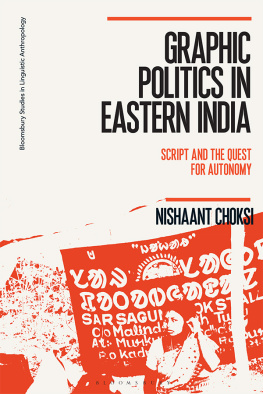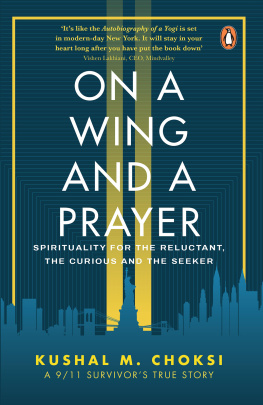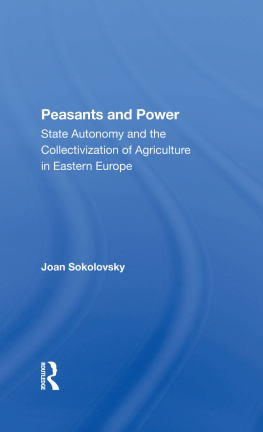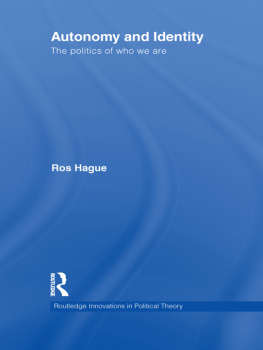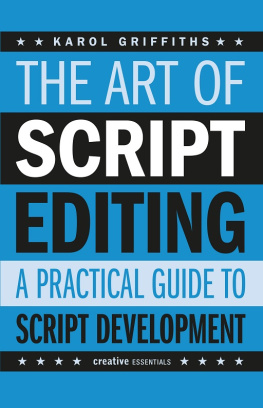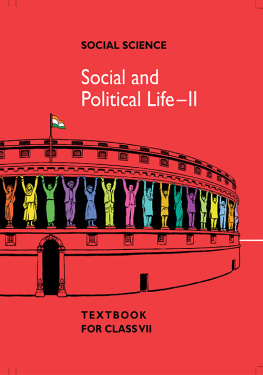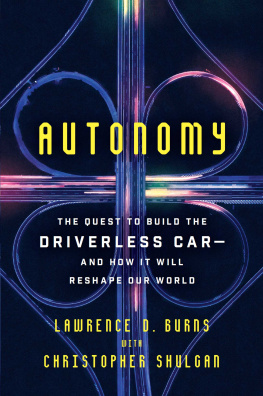Nishaant Choksi - Graphic Politics in Eastern India: Script and the Quest for Autonomy
Here you can read online Nishaant Choksi - Graphic Politics in Eastern India: Script and the Quest for Autonomy full text of the book (entire story) in english for free. Download pdf and epub, get meaning, cover and reviews about this ebook. year: 2020, publisher: Bloomsbury Publishing Plc, genre: Politics. Description of the work, (preface) as well as reviews are available. Best literature library LitArk.com created for fans of good reading and offers a wide selection of genres:
Romance novel
Science fiction
Adventure
Detective
Science
History
Home and family
Prose
Art
Politics
Computer
Non-fiction
Religion
Business
Children
Humor
Choose a favorite category and find really read worthwhile books. Enjoy immersion in the world of imagination, feel the emotions of the characters or learn something new for yourself, make an fascinating discovery.
- Book:Graphic Politics in Eastern India: Script and the Quest for Autonomy
- Author:
- Publisher:Bloomsbury Publishing Plc
- Genre:
- Year:2020
- Rating:5 / 5
- Favourites:Add to favourites
- Your mark:
- 100
- 1
- 2
- 3
- 4
- 5
Graphic Politics in Eastern India: Script and the Quest for Autonomy: summary, description and annotation
We offer to read an annotation, description, summary or preface (depends on what the author of the book "Graphic Politics in Eastern India: Script and the Quest for Autonomy" wrote himself). If you haven't found the necessary information about the book — write in the comments, we will try to find it.
Nishaant Choksi: author's other books
Who wrote Graphic Politics in Eastern India: Script and the Quest for Autonomy? Find out the surname, the name of the author of the book and a list of all author's works by series.
Graphic Politics in Eastern India: Script and the Quest for Autonomy — read online for free the complete book (whole text) full work
Below is the text of the book, divided by pages. System saving the place of the last page read, allows you to conveniently read the book "Graphic Politics in Eastern India: Script and the Quest for Autonomy" online for free, without having to search again every time where you left off. Put a bookmark, and you can go to the page where you finished reading at any time.
Font size:
Interval:
Bookmark:

Graphic Politics in Eastern India
Bloomsbury Studies in Linguistic Anthropology
Series Editors:
Sabina Perrino, Paul Manning and Jim Wilce
Presenting and exploring new and current approaches to discourse and culture, Bloomsbury Studies in Linguistic Anthropology examines the most recent topics in this field. Publishing contemporary, cutting edge research, this series investigates social life through everyday discursive practices, making these practices visible and unveiling processes that would remain concealed without careful attention to discourse.
Titles focus on specific themes to advance the field both theoretically and methodologically, such as language contact dynamics, language revitalisation and reclamation, and language, migration and social justice. Positioning linguistic anthropology at the intersection with other fields, this series will cast light on various cultural settings across the globe by viewing important linguistic ethnographies through an anthropological lens. Standing at the frontier of this growing field, Bloomsbury Studies in Linguistic Anthropology offers a balanced view of the current state of the discipline, as well as promoting and advancing exciting new directions for research.
Titles in the Series:
Graphic Politics in Eastern India
Nishaant Choksi
Language and Revolutionary Magic in the Orinoco Delta
Juan Luis Rodrguez
Remaking Kichwa
Michael Wroblewski
Saying and Doing in Zapotec
Mark A. Sicoli
Graphic Politics in Eastern India
Script and the Quest for Autonomy
Nishaant Choksi

Contents
This book is the product of the generosity and labor of many people in many different places. To thank them all would take much more space than I have available, although I would like to mention a few names here.
First, my deepest gratitude goes to the people of Jhilimili, who have taken care of me as one of their own for several years now. They have been so kind to let me into their homes and lives, and have never become irritated with my nave questions. Sarada Prasad Kisku and the members of the Kherwal Marsal Gaonta have been especially generous, facilitating my stay from the beginning. During my research period, the teachers and staff of the local high school gave me warm company on many a night. Sagun was the best research assistant one could ask for, and this study would not have been possible without his dedication and enthusiasm. In addition, many in the Santali writer and activist community took me under their wing and helped guide this research, including Mahadev Hansda, Nobin Besra, Dilip Hembrom, Parimal Hansda, Kolendranath Mandi, A. K. Soren, Dhuni Soren, and the teachers at the Ol Chiki Secet Asra, Santaragachi.
This project grew from the dissertation I wrote while I was a graduate student at the University of Michigan. My supervisor, Barbra Meek, supported me from early on in my graduate career, and she has been an inspiring mentor and guide ever since. Matthew Hull was also an important interlocutor, and traces of my many conversations with him can be found throughout this book. Judith Irvine and Marlyse Baptista thoroughly read through the dissertation and offered several valuable insights.
It is certainly true that the relationships you make in graduate school will be very important the rest of your career. Many of the friends I made during my time as a graduate student read and discussed chapters of this book with me. This includes Haydar Darici, Christina Davis, Erika Hoffman-Dilloway, Chaise Ladousa, Durba Mitra, K. N. Sunandan, and Susan Thomas. Their comments and suggestions are deeply appreciated. My ongoing conversations with Christopher Berk, Carlos Carmona, Sonia Das, Joshua Friedman, Erica Feldman, Anneeth Hundle, Rachel Lee, Lamia Mognieh, Neha Paliwal, and Gbenga Olumolade, have shaped (and continue to shape) the ideas presented here.
My three years in Japan as a postdoctoral fellow changed many of my ideas and allowed me the time, space, and intellectual freedom to transform a messy dissertation into a proper book. A special debt goes to Masato Kobayashi, Toshiki Osada, Madhu Purti, and Nathan Badenoch who facilitated my stay at Tokyo and Kyoto Universities. In Kyoto, Miles Kenny-Lazar read and discussed with me the entire draft of this book cover to cover over several rounds of coffee at the Kamo Caf, offering a much-needed critical eye. Many other colleagues in Kyoto and Tokyo helped me grow intellectually, motivating me to complete this project, including Rika Yamashita, Takashi Sekine, Takamichi Serizawa, David Dippong, Kia-Meng Boon, and Ai Kawamura.
This book is ultimately a product of my engagement with a diverse range people and places in India. My time in Baroda during 20046 at the Bhasha Centre and the Adivasi Academy working under G. N. Devy introduced me to the wide vista of Indias rich Adivasi cultures and traditions. I thank all my friends and colleagues in Baroda and Tejgadh for caring for me and showing me the way forward. In Kolkata, Animesh Pal, Surhid Kumar Bhowmick, and the late Dhirendranath Bhaske introduced me to Santali and made the initial connections for me. Throughout my field research, Bodhisattva Kar served as my local supervisor, and he and my colleagues at Centre for Studies in Social Sciences (Iman, Debarati, Subhashree, Swati) provided me the intellectual environment to reflect during the often disorienting experience of village-level fieldwork. In Delhi, Prathama Banerjee was always kind, generous, and helpful, inviting me to her home to discuss my work and agreeing to be on my dissertation committee even under difficult circumstances. Finally, I would like to thank my colleagues and students at my current home, IIT Gandhinagar, especially those in the Humanities and Social Sciences discipline who have created a vibrant professional atmosphere where I can advance my ideas, engagements, and collaborations.
As always, my family has stood by me through the many years of fieldwork, traveling, separation, and other hardship. My parents, grandparents, and other family members have always supported my endeavors even if they did not fully understand my goals or motivation. My partner Farah has kept me going throughout, lifting my spirits when things looked low and acting as my ethical and intellectual compass when I was lost. Our many conversations have gone into this book, both in content and in character.
Many thanks also to the team at Bloomsbury, including Andrew Wardell, Becky Holland, and series editors Paul Manning and Sabina Perrino for taking an interest in this work and seeing it through. The research has been funded with generous support from the University of Michigan, Fulbright-Hays/DDRA, AmericaScandinavia Foundation, Japanese Society for the Promotion of Science (P16744), and Research Initiation Grant, IIT Gandhinagar.
Transcribing Santali
As this book concerns the politics of script, how I have chosen to gloss the Santali language terms is an issue that deserves a few words. Some of my interlocutors requested that I use only Ol-Chiki script to transcribe the Santali. However, because this book is meant to be read by a wider, English-reading audience, I have instead chosen to use a modified Roman script to represent Santali words. As a disclaimer, in no way am I arguing that this script is more accurate than Ol-Chiki or Santali Roman or any other script in representing the sounds of Santali. In order to make my transcription choices more transparent, I have provided a table below showing the orthography I have chosen to employ in this book, and its IPA and Ol-Chiki equivalents.
Next pageFont size:
Interval:
Bookmark:
Similar books «Graphic Politics in Eastern India: Script and the Quest for Autonomy»
Look at similar books to Graphic Politics in Eastern India: Script and the Quest for Autonomy. We have selected literature similar in name and meaning in the hope of providing readers with more options to find new, interesting, not yet read works.
Discussion, reviews of the book Graphic Politics in Eastern India: Script and the Quest for Autonomy and just readers' own opinions. Leave your comments, write what you think about the work, its meaning or the main characters. Specify what exactly you liked and what you didn't like, and why you think so.

